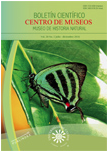Autores/as
Resumen
Varias especies Sesarmidae viven en fitotelmata como una estrategia para evitar la depredación, hallar nutrientes, y proteger a los juveniles. El estudio muestra la presencia de A. angustum asociados con Guzmania sp. (Bromeliaceae) en las selvas de Colombia. A. angustum tiene adaptaciones morfológicas para la escalar que permiten el acceso a las bromelias y otras fitotelmata como otras especies de cangrejos reportados en bromelias y huecos de los árboles. Futuras investigaciones futura podría ser dirigida hacia la explicación de la presencia de A. angustum.
Palabras clave
Citas
CAMPOS, M., 2005.- The freshwater crabs from Colombia. A taxonomy and distributional study; 1-363. (Academia Colombiana de Ciencias Exactas, Físicas y Naturales. Bogotá). Disponible en: http://www.accefyn.org.co/PubliAcad/Cangrejos/Freshwater.pdf.
CAMPOS, N. H., NAVAS, G. BERMÚDEZ, A. & CRUZ, N., 2005.- Los crustáceos decápodos de la franja superior del talud continental (300-500 metros) del mar Caribe colombiano: 1: 272 Monografías de fauna de Colombia. Unilibros, Santa Marta.
CANNICCI, S., FRATINI, S. & VANNINI, M., 1999.- Use of time, space and food resources in the mangrove climbing crab Selatium elongatum (Grapsidae: Sesarminae). Marine Biology, 135: 335-339.
CUMBERLIDGE, N., FENOLIO, D. B., WALVOORD, M.E. & STOUT, J., 2005.- Tree-climbing crabs (Potamonautidae and Sesarmidae) from phytotelmic microhabitats in rainforest canopy in Madagascar. Journal of Crustacean Biology, 25: 302-308.
DE GRAVE, S., PENTCHEFF, N.D., AHYONG, S.T., CHAN, T.-Y., CRANDALL, K.A., DWORSCHAK, P.C., FELDER, D.L., FELDMANN, R.M., FRANSEN, C.H.J.M., GOULDING, L.Y.D., LEMAITRE, R., LOW, M.E.Y., MARTIN, J.W., NG, P.K.L., SCHWEITZER, C.E., TAN, S.H., TSHUDY, D. & WETZER, R., (2009).- A classification of living and fossil genera of decapod crustaceans. The Raffles Bulletin of Zoology, Suppl. 21, 1-109.
DIESEL, R., 1989.- Parental care in an unusual environment: Metopaulias depressus (Decapoda: Grapsidae), a crab that lives in epiphytic bromeliads. Animal Behaviour, 38: 561-575.
________, 1992.- Maternal care in the bromeliad crab, Metopaulias depressus: protection of larvae from predation by damselfly nymphs. Animal Behavior, 43: 803-812.
________, 1997.- Maternal control of calcium concentration in the larval nursery of the bromeliad crab, Metopaulias depressus (Grapsidae). Proceedings of the Royal Society, (Biological Sciences) 264: 1403 -1406.
ERICKSON, A.A., SALTIS, M., BELL, S.S. & DAWES, C.J., 2003.- Herbivore feeding preferences as measured by leaf damage and stomatal ingestion: a mangrove crab example. Journal of Experimental Marine Biology and Ecology, 289: 123 - 138.
FRATINI, S., VANNINI, M. CANNICCI, S. & SCHUBART, C.D., 2005.- Tree-climbing mangrove crabs: a case of convergent evolution. Evolutionary Ecology Research, 7: 219-233.
GRAY, H.M., & CHRISTY, J., 2000.- Predation by the grapsid crab, Armases angustum (Smith, 1870), on tadpoles of the green poison frog, Dendrobates auratus (Girard, 1855). Crustaceana, 73: 1023-1025.
HARTNOLL, R.G., 1975.- The Grapsidae and Ocypodidae (Decapoda: Brachyura) of Tanzania. Journal of Zoology, London, 177: 305-328.
____________, 1988.- Evolution, systematics, and geographical distribution. In: W.W. BURGGREN & B.R. MCMAHON (eds.), Biology of the land crabs: 6-54. (Cambridge University Press, Cambridge).
JONES, D.A., 1984.- Crabs of the mangal ecosystem. In POR, F.D. & DOR, I. (eds.), Hydrobiology of the Mangal- The Ecosystem of the Mangrove forests. Developments in Hydrobiology, 20: 89 -109.
LEMAITRE, R. & ALVAREZ, R., 1992.- Crustáceos decápodos del Pacífico colombiano: lista de especies y consideraciones zoogeográficas. Anales del Instituto de Investigaciones Marinas y Costeras de Punta Betín, 21: 33-76.
LAZARUS-AGUDELO, J. & CANTERA-KINTZ, J.R., 2007.- Crustáceos (Crustacea: Sessilia, Stomatopoda, Isopoda, Amphipoda, Decapoda) de Bahía Málaga, Valle del Cauca (Pacífico colombiano). Biota Colombiana, 8: 221-239.
MENDEZ, J. & AMÉZQUITA, A., 2014.- Physical combat in the poison-arrow frog, Kokoé-pá (Oophaga histrionica) from Arusi, Choco, Colombia. Herpetology Notes, 7: 1-2.
NG, P.K.L., GUINOT, D. & DAVIE, P.J.F., 2008.- Systema Brachyurorum. Part I. An annotated checklist of extant brachyuran crabs of the world. Raffles Bulletin of Zoology, 17: 1-286.
NG, P.K. & LIU, H.C., 2003.- On a new species of tree-climbing crab of the genus Labuanium (Crustacea: Decapoda: Brachyura: Sesarmidae) from Taiwan. Proceedings of the Biological Society of Washington, 116: 601-616.
SCHUBART, C.D., & SANTL, T., 2014.- Differentiation within a river system: ecology or geography driven? Evolutionary significant units and new species in Jamaican freshwater crabs, p. 173-193. In: Yeo, D.C.J., Cumberlidge, N. & S. Klaus (eds.), Crustaceana Monogrphs 19: advances in freshwater decapod systematics and biology. Brill Publ., Leiden.
SCHUBART, C.D., CUESTA, J.A. & FELDER, D.L., 2002.- Glyptograpsidae, a new brachyuran family from Central America: larval and adult morphology, and a molecular phylogeny of the Grapsoidea. Journal of Crustacean Biology, 22: 28-44.
_________, LIU, H. & CUESTA, J., 2003.- A new genus and species of tree-climbing crab (Crustacea: Brachyura: Sesarmidae) from Taiwan with notes on its ecology and larval morphology. Raffles Bulletin of Zoology, 51: 49-59.
SIVASOTHI, N. 2000.- Niche preferences of tree-climbing crabs in Singapore mangroves. Crustaceana, 73: 25-38.
THIERCELIN, N & SCHUBART, C.D., 2014.- Transisthmian differentiation in the tree-climbing mangrove crab Aratus H. Milne Edwards, 1853 (Crustacea, Brachyura, Sesarmidae), with description of a new species from the tropical eastern Pacific. Zootaxa, 3793 (5): 545-560.
VALENCIA, D.M. & CAMPOS, M.R., 2007.- Freshwater prawns of the genus Macrobrachium Bate, 1868 (Crustacea: Decapoda: Palaemonidae) of Colombia. Zootaxa, 1456: 1-44.
VALLEJO, M.I., LONDOÑO, A.C., LÓPEZ, R. GALEANO, G., ÁLVAREZ, E. & DEVIA, W., 2005.- Establecimiento de parcelas permanentes en bosques de Colombia. Instituto de Investigación de Recursos Biológicos Alexander von Humboldt. Bogotá D. C., Colombia. (Serie: Métodos para estudios ecológicos a largo plazo; No. 1).
VANNINI, M., OLUOCH, A. & RUWA, R.K., 1997.- Tree-climbing decapods of Kenyan mangroves. In KJERFVE, B., DE LACERDA, L. D & DIOP, E.H.S. (eds.), Mangrove Ecosystem Studies in Latin America and Africa. UNESCO Technical Papers in Marine Sciences. New York: UNESCO.

 PDF (English)
PDF (English)
 FLIP
FLIP























